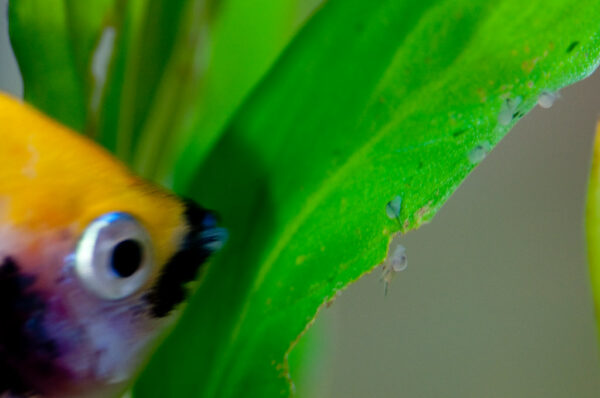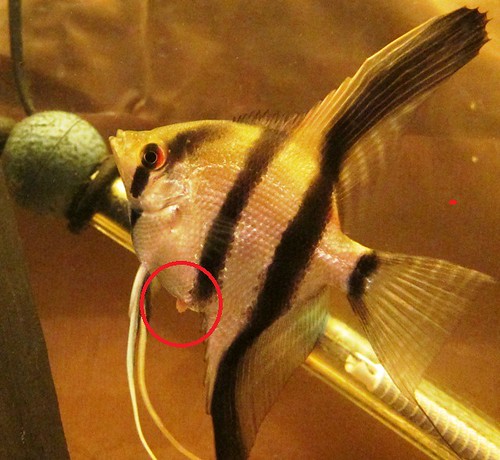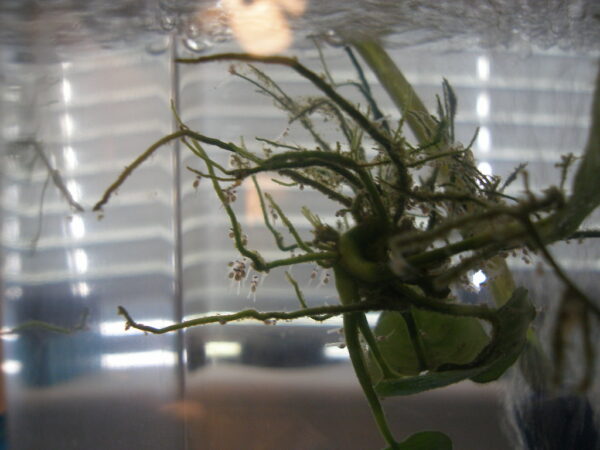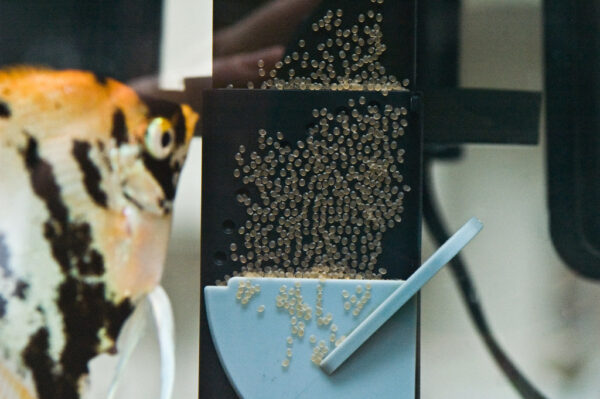Breeding freshwater angelfish holds a special place in my heart, beginning as a captivating hobby during my high school years. The challenge, however, often unfolded after the spawning, when nurturing the eggs to maturity became my responsibility. Raising angelfish eggs, while not excessively difficult, required a blend of patience and precision. It was about creating the perfect environment where these delicate eggs could thrive. The most crucial aspects were safeguarding the eggs and ensuring the fry had ample nourishment. Mastering these tasks was the key to my success, transforming this journey into a fulfilling experience. Watching the eggs hatch and the fry grow into a healthy school of angelfish was not just a triumph in fish breeding but also a deeply personal accomplishment from my early forays into the aquatic world.
Basics of Breeding Angelfish
Breeding angelfish begins with providing a conducive environment for spawning, typically involving a separate breeding tank to ensure safety and cleanliness. The process involves a pair of angelfish selecting a flat surface for laying eggs, which are then fertilized by the male. It's crucial to maintain optimal water conditions and a stress-free environment, as angelfish are sensitive to changes and disturbances. Monitoring water quality and temperature closely is key to ensuring the health of both the eggs and the adult fish throughout the breeding process.
Angelfish Eggs Stages:
Laying the Eggs
The egg-laying stage is a meticulous process where the female angelfish carefully deposits her eggs, usually on a flat, cleaned surface like a leaf or a specially provided slate. These eggs, sticky and transparent, are laid in neat rows. Following this, the male angelfish fertilizes them. It's crucial at this stage to ensure the environment is calm and stable, as angelfish can react sensitively to disturbances.
Pre-Hatching Stage
Approximately 60 hours after laying, the angelfish eggs enter the pre-hatching stage. Here, the embryos are well-developed, curled around their yolk sacs. The egg walls become increasingly transparent, making it possible to observe the beating heart and blood flow of the larvae under magnification. This stage requires careful monitoring to ensure the health and development of the embryos.

Wiggler Stage
Post-hatching, the angelfish eggs transition into the 'wiggler' stage. The larvae, now hatched, remain attached to the spawning site via a filament protruding from their heads. During this critical stage, the larvae's eyes, tails, and internal organs continue to develop. They primarily rely on their yolk sacs for nutrition, eliminating the need for additional feeding.

Free-Swimming Fry
Caring for Angelfish Eggs
The care of angelfish eggs is a delicate process that requires a stable and clean environment. Once the eggs are laid, it's vital to maintain optimal water conditions, including temperature, pH levels, and cleanliness, to prevent fungal growth. The use of an air stone can help ensure proper oxygenation. If there’s a risk of the parent angelfish eating the eggs, or if they seem inexperienced or stressed, it may be necessary to move the eggs to a separate breeding tank. In this tank, treating the water with a mild fungicide like methylene blue can help protect the eggs from fungus and other harmful pathogens. Regular monitoring of the eggs for signs of fungus or unfertilized eggs is crucial, as these should be promptly removed to prevent contamination.
Caring for Angelfish Fry
Once the angelfish eggs hatch and enter the free-swimming fry stage, the focus shifts to feeding and protecting the delicate fry. Initially, they will feed on infusoria or other microscopic organisms present in the tank. After a couple of days, they can be fed with specially formulated fry foods, like freshly hatched brine shrimp or micro worms. As they grow, gradually introduce crushed fish food into their diet. It’s also important to maintain pristine water conditions, as fry are particularly sensitive to water quality. Regular, gentle water changes are recommended to keep the environment clean and safe. Providing ample hiding spaces and a calm environment helps the fry feel secure and aids in their development. Some aquarists prefer to move the fry to a grow-out tank, where they can be closely monitored and cared for until they are ready to join the main aquarium.
Angelfish Eggs Hatching Time:
The hatching time for angelfish eggs typically ranges between 48 to 72 hours post-fertilization, depending on the water temperature. Warmer water can accelerate the hatching process, while cooler temperatures may extend it. It's crucial to keep the water temperature stable within the ideal range (about 78-80°F or 25-27°C) to ensure healthy development and timely hatching of the eggs.
How To Tell If Angelfish Eggs Are Fertilized:
Fertilized angelfish eggs can be identified by their clear or slightly amber appearance. As they develop, you may notice a small dark spot in each egg, which is the developing embryo. In contrast, unfertilized eggs often turn white or opaque, indicating that they are not viable and can potentially develop fungal growth. These unfertilized eggs should be removed from the breeding tank to prevent the spread of fungus to the fertilized eggs.
What Do Angelfish Eggs Look Like:
Angelfish eggs are small, round, and typically have a clear or slightly amber hue. They are sticky, allowing them to adhere to the surface where the female lays them, such as a leaf or a flat slate. The eggs are often laid in neat rows and, if fertilized, will have a tiny dark spot in the center, which is the developing embryo.
Angelfish Eggs Hatching:
During the hatching process, the angelfish eggs will show signs of tiny larvae emerging. These larvae, known as 'wigglers', will initially remain attached to the hatching surface by a filament. At this stage, they are mostly immobile and will consume the nutrients from their attached yolk sacs. The hatching process is a critical time, and the larvae are very delicate, requiring a stable and clean environment.
Angel Fish Eggs Turning White:
When angelfish eggs turn white, it typically indicates that they are unfertilized or have been infected by a fungus. Unfertilized eggs do not develop and start to decay, which can lead to fungal growth. Such eggs pose a risk to the fertilized ones and should be removed promptly to maintain the health and viability of the remaining eggs. White eggs are a common occurrence, especially with inexperienced breeding pairs or in suboptimal breeding conditions.
Do Angelfish Mate for Life?
Angelfish do not necessarily mate for life. While they can form long-term pair bonds, these bonds can break, especially if the pair fails to successfully breed or raise fry. Angelfish may choose different partners over their lifetime, particularly in an aquarium setting where they have the opportunity to interact with multiple potential mates.
What are the Signs that Angelfish are Ready to Breed?
Signs that angelfish are ready to breed include more vivid colors, increased territorial behavior, and the cleaning of a flat surface for egg-laying. The female's belly will become fuller as she is ready to lay eggs, and the male may display courting behaviors, such as following the female closely and fluttering his fins.
How do Angelfish Lay Eggs?
Angelfish lay eggs on flat surfaces, such as leaves, rocks, or specially provided breeding slates in aquariums. The female deposits rows of tiny, sticky eggs on the chosen surface, and the male follows behind to fertilize them. This process is typically repeated until several hundred eggs have been laid.

Can Angelfish Lay Eggs Without a Mate?
Female angelfish can lay eggs without a mate, but these eggs will not be fertilized and won't develop into fry. Females may occasionally lay unfertilized eggs even without the presence of a male, a behavior often referred to as 'spawning'.
Does the Male or Female Angelfish Guard the Eggs?
Both male and female angelfish typically take turns guarding and caring for the eggs. They fan the eggs with their fins to provide oxygen and remove any infertile or fungus-infected eggs. This cooperative parenting behavior continues until the eggs hatch and even as the fry begin to swim freely.
Why Do My Angelfish Keep Eating Their Eggs?
Angelfish may eat their eggs for several reasons, including stress, lack of proper nutrition, or inexperience as parents. Sudden changes in the tank environment, poor water quality, or disturbances from other fish or external movement can cause stress, leading to this behavior. Inexperienced angelfish pairs, particularly on their first few spawning attempts, may also consume their eggs.
Noise and Movement:
Excessive noise and movement around the aquarium can stress angelfish, potentially leading them to eat their eggs. It's important to provide a calm and stable environment for breeding angelfish, especially during the egg-laying and hatching phases, to avoid startling the fish and triggering this defensive response.
What Do You Do With Angelfish Eggs?
Once angelfish lay eggs, you should ensure they are in a safe and clean environment. This includes maintaining optimal water conditions and monitoring for any signs of fungus or unfertilized eggs. If the parent fish are experienced and not stressed, they can care for the eggs themselves. However, if there is a risk of the eggs being eaten or if the parents are inexperienced, you may consider moving the eggs to a separate breeding tank.
How Do You Hatch Angelfish Eggs Without the Parents?
To hatch angelfish eggs without the parents, transfer the eggs to a separate, clean tank with stable water conditions similar to the main tank. Use an air stone to gently oxygenate the water and add a mild antifungal agent like methylene blue to prevent fungal growth. Keep the tank in a quiet area and monitor the eggs until they hatch, typically within 48-72 hours.
Should I Remove Angelfish Eggs?
Whether to remove angelfish eggs depends on the parents' behavior and the tank environment. If the parents are attentive and the tank is calm and free of threats from other fish, the eggs can be left with them. However, if the parents are inexperienced, stressed, or show signs of eating the eggs, it’s safer to remove the eggs to a separate breeding tank.
How Many Fry Do Angelfish Have?
The number of fry an angelfish can have varies widely, often ranging from a few dozen to several hundred. The actual number depends on factors like the health, age, and size of the angelfish, as well as the conditions of their environment.
How Fast Do Angelfish Fry Grow?
Angelfish fry grow relatively quickly, especially with proper care and nutrition. In the first few weeks, they show rapid growth, and within a couple of months, they start to develop distinct angelfish features. Their growth rate can be influenced by factors like diet, tank conditions, and genetics.
How Long Does It Take for Angelfish Fry to Look Like Angelfish?
Angelfish fry typically start to resemble miniature adult angelfish within a few months. By around six months, they will have developed the distinct body shape and finnage characteristic of angelfish, although they may not reach full size and coloration until they are about a year old.
When Should I Start Feeding Angelfish Fry?
You should start feeding angelfish fry as soon as they become free-swimming, which is usually about 3-5 days after hatching. Initially, they can be fed infusoria or specially formulated fry foods. As they grow, you can gradually introduce newly hatched brine shrimp and finely crushed flake food. Regular, small feedings are important for their growth and development.

How Long Can Angelfish Fry Go Without Food?
Angelfish fry should not go without food for more than a day once they start free-swimming. Initially, they rely on their yolk sacs for nutrition, but after this is depleted (usually 3-5 days post-hatching), they require regular feeding to support their rapid growth and development.
How Many Times a Day Should I Feed Angelfish Fry?
Angelfish fry should be fed small amounts of food several times a day, typically 3-5 times. Frequent feedings are essential as fry have high metabolic rates and need a constant supply of nutrients to grow properly. The food should be appropriate for their size, such as infusoria, finely crushed flake food, or newly hatched brine shrimp.
Should I Separate Angelfish Fry from Parents?
Whether to separate angelfish fry from their parents depends on the behavior of the parents and the setup of your tank. If the parents are attentive and protective, the fry can be left with them. However, if there’s a risk of the parents eating the fry, or if aggression is observed, it’s safer to move the fry to a separate grow-out tank.
Will Angelfish Fry Survive in a Community Tank?
Angelfish fry surviving in a community tank is challenging. They are vulnerable to being eaten by other fish and may struggle to compete for food. Ideally, angelfish fry should be raised in a separate, species-specific tank where conditions can be closely monitored and controlled.
How Long Does It Take for Angelfish Fry to Look Like Angelfish?
It typically takes several months for angelfish fry to develop the distinct body shape and finnage of adult angelfish. By around six months, they will resemble miniature adults, although they may not reach full size and coloration until about a year old.
How Often Do Angelfish Lay Eggs?
Angelfish can lay eggs as frequently as every two weeks, provided they are in good health and the conditions in their tank are optimal. However, this frequency can vary based on factors like the age, health, and stress levels of the angelfish, as well as the quality of the tank environment. Frequent spawning can be taxing on the fish, so some breeders choose to limit the frequency for the health of the angelfish.

In conclusion, breeding and raising angelfish offers a fascinating and rewarding experience in the world of aquarium keeping. From understanding the delicate process of egg laying and hatching to ensuring the healthy growth of fry, each stage demands attention and care. Feeding the fry multiple times a day, deciding whether to separate them from their parents, and providing the right conditions are crucial steps in nurturing these young fish. While challenges like maintaining them in a community tank exist, with proper care and knowledge, raising angelfish fry can be a successful and enriching endeavor. Whether you're a seasoned aquarist or a beginner, the journey of bringing up angelfish from eggs to graceful adults is a remarkable journey that deepens one's appreciation for these elegant creatures and the delicate balance of aquatic life.



